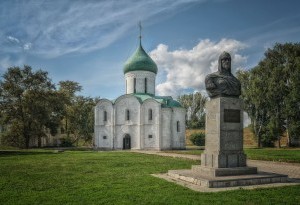Transfiguration Cathedral in the Pereslavl-Zalessky

The Savior Transfiguration Cathedral in the Pereslavl Kremlin is the only one of the five first white-stone churches of Northeast Russia, which has come down to us almost completely safe and unchanged. Even his same age, the church of Boris and Gleb in Kideksha, eventually lost its original appearance.
The cathedral was built in 1152, under Prince Yuri Vladimirovich Dolgoruky. Until Yuri Dolgoruky, who began to settle in the Vladimir-Suzdal lands at the beginning of the XII century, no one here built stone. Northeastern Russia was what is called a "wild land".
White stone looks majestic, but as a building material impractical: expensive, difficult to transport, porous, quickly absorbs moisture and dirt. However, the choice of white stone had a symbolic meaning: not sparing the means and efforts, the prince sought to show his power, following the example of the Western European rulers. Yury Dolgoruky understood the meaning of “monumental propaganda” perfectly well - later this tradition was continued and developed by his son, Prince Andrey Bogolyubsky.
By order of Yuri, for the first time in Russia deposits of white stone (limestone) were explored and European stone-building techniques were used. The question of who the architects and builders of the cathedrals of Yuri were, still does not have a definite answer. According to the most common version, builders were invited from the Galician principality. According to recent studies of the famous historian of ancient Russian architecture S.V.Zagraevsky, Prince Yury used local masters who had been trained in Western Europe. Most likely in Germany.
The architectural connection between the buildings of the epoch of Yury Dolgoruky (and then Andrey Bogolyubsky) and the Western European cathedrals of the Romanesque style is obvious. The ornamental decor of the “universal” Romanesque type that adorned many temples of Western Europe is traced in the design of the Pereslavl Transfiguration Cathedral and the Church of Boris and Gleb in Kideksha.
Already after the death of Yury Dolgoruky (in 1157), in the second half of the XII century, the cathedral was painted with frescoes. The compositions “Last Judgment” and “The Virgin on the Throne” were discovered in 1862 by local historian and architect N.А. Artleben.
Unfortunately, at the end of the 19th century, a restoration was carried out in the Transfiguration Cathedral, during which the ancient frescoes were removed. The only surviving fragment of murals (belt image of the Apostle Simon) is currently located in the State Historical Museum in Moscow. Now inside the cathedral white walls.
Alexander Nevsky Museum
After the revolution, at the very beginning of the 1920s, services in the temple were discontinued. The main relics of the cathedral - the chalice of Yuri Dolgoruky and the Gospel of the deacon Zinovy - were taken to Moscow, to the Historical Museum. The rest of the church values were transferred to Pereslavl-Zalessky Museum-Reserve, which was founded in 1920. Later, the temple itself was taken over by the museum.
Immediately after the end of the Great Patriotic War, the Pereslavl Museum-Reserve decided to organize an exhibition dedicated to the native of Pereslavl-Zalessky, Prince Alexander Nevsky. The impetus was that during the war years, the famous Russian commanders were elevated to the rank of cult personalities, both officially and in popular consciousness. In July 1942, the Order of Alexander Nevsky was established.
They decided to place the exhibition in the Transfiguration Church. There were several reasons for this. Firstly, there appeared a reasonable reason to open the temple to visitors, while not only covering the episodes of the Russian military history of the first half of the XIII century, but also to acquaint people with the wonderful creation of the architects of the XII century. Secondly, according to sources, the chambers of Alexander Nevsky, in which the prince lived during his stay in Pereslavl-Zalessky, stood right next to the Transfiguration Cathedral. In addition, it is believed that in this church of Alexander Nevsky was baptized (he was born, presumably, in 1220).
The exhibition opened on September 2, 1945. The exhibits were very different, but all somehow connected with the name of Nevsky. For example, among the artifacts was exhibited the tomb with the remains of the grandson of Alexander Nevsky - Ivan Dmitrievich, Pereslavsky appanage prince, as well as objects found during archaeological excavations in Pereslavl-Zalessky, samples of the building material from which the temple was erected, unique books. An important part of the exhibition was personal belongings and diplomas of Soviet soldiers who were awarded the Order of Alexander Nevsky. Upon learning of the opening of the exhibition of this kind, the order bearers themselves handed them over to the museum.
The exhibition aroused great interest among the public, so in the same 1945 it was decided to make it permanent, and the Transfiguration Cathedral was transformed into the Alexander Nevsky Museum. Over time, the exhibition was replenished with a monument of white stone in honor of the founders and builders of the city: the princes Yuri Dolgoruky. Andrei Bogolyubsky, Alexander Nevsky and Ivan Dmitrievich; the bust of Alexander Nevsky; paintings depicting different pages of the life of the famous military leader. All these exhibits were created by Soviet artists and sculptors. In 1958, a monument was erected near the cathedral to Alexander Nevsky, outwardly resembling actor Nikolai Cherkasov, who played the prince in the classic Eisenstein film.
Collections are replenished in our days. The temple is still subordinated to the museum, although sometimes there are still worship services. It is important to note that the Transfiguration Cathedral is a summer one, and therefore it is open only from May to October.
Join our tours and take a look at this amazing attraction:
Excursions - www.uvisitrussia.com/day-tours/tours-to-golden-ring/
Tours - www.uvisitrussia.com/tours-to-golden-ring/



